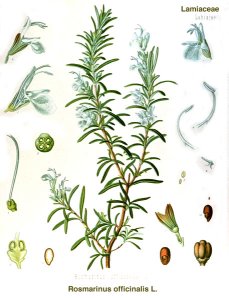 |
Rosemary
|
 Rosemary: Rosemarinus officinalis (Linn.)
Rosemary: Rosemarinus officinalis (Linn.)
Natural order: Labiatae
Rosemary extract, anti-oxidant, water soluble
Rosemary mixed extracts; Diterpenes (Carnosol + carnosic acid)
Rosemary is an antioxidant and in that role it has some unique capabilities. Most antioxidants need to go through a re-cycling or replenishment to maintain anti-oxidant capability once it is used. Vitamin E, for instance, must be re-cycled after quenching a free radical before it can quench another. It is interesting that there is some evidence that rosemary helps in the recycling of Vitamin E. Rosemary as an antioxidant has a cascade effect. The molecule, carnosic acid, starts the cascade. After carnosic acid neutralizes a free radical it is transformed into carnosol which can neutralize another free radical. This cascade continues through rosmanol, and galdosol thus neutralizing several free radicals without re-cycling.1,2
With the current health care worries about brain function and aging the effect of rosemary on nerve growth is exciting. There is a US Patent, 6479549, which discusses the use of a carnosic acid derivative to promote the production of Nerve Growth Factor.3,4,5 It has been found that this neurotrophic factor,NGF, has a great effect on nerve denaturing diseases. NGF is essential for maturation and survival of sensory and sympathetic nerves in the peripheral nervous system as well as large cell cholinergic neurons in the central nervous system. Consequently it is likely that elevation of the NGF level would be effective in treating Alzheimer dementia and cerebrovascular dementia and also lesions of the peripheral nervous system such as those associated with diabetes.
In the more mundane health concerns about lipids its effectiveness as an antioxidant is high. In the realm of food preservation in the food production industry it is an excellent antioxidant.7,8,9 Carnosic acid (rosmaricine) and rosmarinic acid are widely used in the food industry to protect products from oxidative damage. The generally used food industry anti-oxidants, BHA and BHT, have been approved by the FDA. However the same two chemicals produce oxidative products when doing this job which may have tumorgenicity.10 Rosemary antioxidant is more functional than BHA or the tea polyphenols and does not have potentially toxic oxidative properties. 10
If one worries about the possibility of radiation damage in today's contentious world then they should keep a supply of rosemary handy. A current study found that a rosemary leaf extract is effective in the treatment of radiation damage to the body.11 Specifically the leaf extract was used in Swiss albino mice to treat radiation-induced haemotological damage. Rosemary treated groups showed a dose dependent rise in the number of leucocytes. Radiation produced an increase in the lipid peroxidation levels and a reduction in the glutathione levels. Rosemary treated animals showed a significant decrease in lipid peroxidation levels and a rise in glutathione content.
These technical investigations show that rosemary is an exceptionally useful herb both within and without the human body and in the general food industry.
Rosemary has long been used in food preparation and in particular in those Mediterranean countries where it originated. In England it has been used extensively in food preparation ever since its introduction by the Countess of Hainault. Some of these uses will be discussed subsequently.
- References:
-
1. MDidea, technical data sheet
2. Antioxidant Mechanism of Carnosic Acid: Structural Identifidation of Two Oxidation Products; Masuda, et al., J. Agric. Food Chem., 49 (11), 5560-5565, 2001
3. Carnosic acid derivatives for promoting synthesis of nerve growth factor, US Patent 6479549, Kosaka, K., et al, 2002
4. Carnosic Acid, a Component of Rosemary (Rosmarinus officinalis L.), Promotes Synthesis of Nerve Growth Factor in T98G Human Glioblastoma Cells, Kosaka, K.,et al, Biological and Pharmaceutical Bulletin, 26(2003), No. 11, 1620
5. Rosemary Chicken Protects Your Brain from Free Radicals, Life Science News, 10/30/2007 6. Effect of rosemary extract, chitosan and ά-tocopherol on lipid oxidation and colour stability during frozen storage of beef burgers.,Georgantelis, D., et al, Meat Science, Vol 75, Issue 2, February 2007, pp 256-264,
7. Nutrition Science News, July 2000
8. Anti-oxidant and pro-oxidant properties of active rosemary constituents: Carnosol and carnosic acid; Aruoma O., et al, Xenobiotica 1992; 22(2):257- 268
9. Enhancing the antioxidant effect of alpha tocopherol with rosemary in inhibiting catalyzed oxidation caused by Fe2 and hemoprotein; Fang, X, et al;Food Res Intl 1993;26:405-411
10. Rosemary and Rosemary Extract, Rosmarinic Acid, Diterpenes, Carnosol, Carnosic acid, Functions and Actions of Rosemary, MDidea, Technical Data Sheet, 2007
11. Role of Rosemary Leaf Extract Against Various Doses of Gamma Radiation; Sancheti, G., et al; Trees for Life Journal, 2007, Vol 2:2